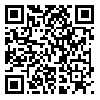BibTeX | RIS | EndNote | Medlars | ProCite | Reference Manager | RefWorks
Send citation to:
URL: http://jbrms.medilam.ac.ir/article-1-260-en.html
Introduction: Advanced oxidation processes (AOPs) suggest a highly reactive, nonspecific oxidant namely hydroxyl radical (OH•), that oxidize a wide range of pollutants fast and non-selective in wastewater and water.
Materials and methods: In this work, the nitrogen-doped titanium dioxide nanoparticles were primed by sol-gel method, characterized by X-ray diffraction and Scanning Electron Microscopy (SEM), for the degradation of Acid Red 40 (AR 40) solution in water. The effectiveness of the treatment method applied for the degradation of AR 40 based on AOPs was investigated.
Results: The three various key parameters were optimized by using response surface modeling, namely: pH, TiO2-N concentration and the initial AR 40 concentrations. The optimized values were obtained at pH = 11, TiO2-N concentration = 0.09 g/L, and the initial AR 40 concentration = 19 mg/L.
Conclusion: Under the optimum conditions, performance of photocatalytic degradation reaches 92.47% in 1 hr. Kinetic constant was evaluated using first-order equation to obtain the rate constant, K.
Received: 2016/06/1 | Accepted: 2016/08/4 | Published: 2016/09/30
| Rights and permissions | |
 |
This work is licensed under a Creative Commons Attribution-NonCommercial 4.0 International License. |





